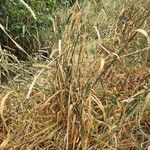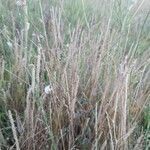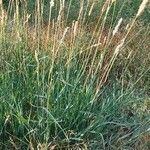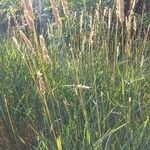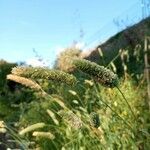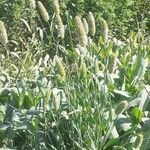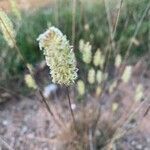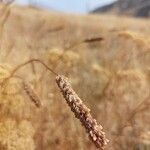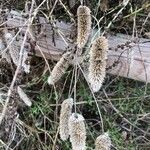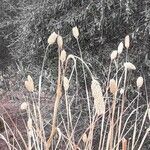Strong perennial clumps, 60-200 cm, from short, knotted rhizome, shoots slightly swollen and ± tuberous at base. Leaf-sheath firm, glabrous, striate, light brown or brownish green. Ligule 4-9 mm, rounded. Leaf-blade 15-60 cm × 5-11 mm, very minutely scabrid, adaxially becoming smooth; margins slightly thickened, minutely scabrid, tapered to long, fine, acuminate tip. Culm 55-180 cm. Panicle (2.5)-3.5-12-(20) × 0.8-2.5-(3) cm, cylindric, oblong or slightly tapered at upper or both ends, occasionally lobed; rachis smooth, branches very sparsely scabrid, hidden. Spikelets 4.5-6.5 mm, light green. Glumes ± equal, 3-nerved, elliptic-lanceolate with deeper green ciliolate wing in upper ½, glabrous, evenly curved towards subacute tip. Ø florets: lemmas unequal, lower 0.5-1 mm, upper 1.2-1.7 mm, lanceolate, acute, sparsely hairy. ☿ floret: lemma 3-3.7 mm, ovate, subacute, with ± sparse, short, fine, silky hairs; palea narrower than lemma; anthers (2.2)-3-4 mm; caryopsis 2.2-2.6 × 1-1.3 mm.
Loosely tufted perennial, up to 1.5 m high; culms often bulbous at base, lateral culms geniculately ascending. Leaf blade 180-350 x 2-15 mm; ligule an unfringed membrane. Inflorescence a panicle, 15-110 x 10-25 mm, occasionally interrupted at base. Spikelets 4.5-7.5 mm long, laterally compressed; glumes ± equal, much longer than spikelet, glabrous, broadly winged, margins entire. Florets usually 2, lowest floret reduced, sterile, 1.4-1.6 mm long, densely pubescent, rarely a second sterile floret present, then < 0.5 mm long; uppermost floret bisexual, 3.1-4.6 x 1.2-1.5 mm, hard, densely pubescent; anther 1.5-3.5 mm long. Flowering time Nov.-Apr.
Loosely tufted perennial up to 1500 mm high, culm base often bulbous, lateral culms geniculately ascending. Leaf blade 180-350 x 2-15 mm. Inflorescence 15-110 x 10-25 mm, occasionally interrupted at the base. Spikelet 4.5-7.5 mm long; glumes glabrous, pale green with dark green longitudinal stripes, broadly winged, margins entire; sterile floret usually one, 1.4-1.6 mm long, densely pubescent, rarely second sterile floret present, then shorter than 0.5 mm; fertile floret 3.1-4.6 x 1.2-1.5 mm, densely pubescent; anther 1.5-3.5 mm long.
Perennial, tufted. Culms 50–150 cm tall, often bulbously thickened at base. Uppermost leaf sheaths not inflated; leaf blades 3–8 mm wide; ligule 3–7 mm. Panicle spikelike, cylindrical, 1.5–11 cm, sometimes lobed at base. Spikelets elliptic-oblong; glumes 5–7 mm, winged, wing margin entire, apex acute; sterile lemma 1(–2), subulate, 0.2–2.2 mm, pubescent, second lemma (when present) up to 0.5 mm; fertile lemma lanceolate, 3–4.6 mm, densely pubescent. Anthers 3–3.5 mm. 2n = 28.
Perennial, loosely tufted (lateral culms geniculately ascending), up to 1.5 m high. Leaf blades 180-350 mm long, 2-15 mm wide. Spikelets 4.5-7.5 mm long. Panicle 15-110 mm long, 10-25 mm wide, occasionally interrupted at base; glumes broadly winged, margin entire; female-fertile floret densely pubescent; sterile floret usually one, 0.2-2.2 mm long (rarely with a second sterile floret, which is then shorter than 0.5 mm).
Perennial; up to 1.5 m high; loosely tufted. Culms laterally geniculately ascending. Leaf blades 180-350 x 2-15 mm. Flowers: panicle compact; spike-like; 15-110 x 10-25 mm; occasionally interrupted at base; spikelets 4.5-7.5 mm long; glumes broadly winged; margins entire; female-fertile floret densely pubescent; sterile floret usually 1; 0.2-2.2 mm long; rarely with a second sterile floret; < 0.5 mm long.
Perennial to 1.5 m. Leaves lanceolate. Spikelets 4-8 mm long, in a cylindrical, spike-like panicle 2-11 cm long, glumes broadly winged, sterile floret 1, sometimes 2.
